✓ Accommodations✓ Flights✓ Rental Cars
Planning a trip to Okayama Prefecture requires more than just choosing a destination; it demands timing your visit perfectly to make the most of your travel experience.
Located in a unique geographical position, Okayama enjoys a climate that is often more favorable than other parts of Japan. Understanding the weather patterns and seasonal attractions is crucial to making the most of your trip.
As you consider the time to visit Japan, particularly Okayama Prefecture, you’ll want to know which month offers the ideal conditions for your interests. Whether you’re drawn to cherry blossoms or autumn foliage, this guide will help you determine the perfect time for your trip.
Understanding Okayama Prefecture’s Climate
Okayama Prefecture boasts a climate that is characteristic of its western Japan location, with nuances that are worth exploring for travelers. Located in the heart of the Seto Inland Sea region, Okayama’s weather is influenced by its geography, making it distinct from other parts of Japan.
Geographic Location and Its Impact on Weather
Okayama’s position on the Asian continent and its proximity to the Seto Inland Sea play significant roles in shaping its climate. The prefecture’s weather is characterized by mild winters and warm summers, largely due to its coastal location, which moderates temperature extremes. The Seto Inland Sea’s influence also means that Okayama typically receives less rainfall than Japan’s Pacific coast, making it a relatively dry region compared to other parts of the country.
The Four Distinct Seasons of Okayama
Okayama experiences four distinct seasons, each offering a unique aspect of the prefecture’s natural beauty. Spring brings cherry blossoms, summer is marked by warm temperatures and vibrant festivals, autumn is renowned for its foliage, and winter, while cool, is generally mild. This seasonal variation makes Okayama a year-round destination, with each season offering different activities and experiences for visitors.
- Spring: Cherry blossoms and mild temperatures
- Summer: Warm weather and festivals
- Autumn: Beautiful foliage
- Winter: Mild temperatures, ideal for certain activities
How Okayama’s Weather Differs from Other Japanese Regions
Compared to other major Japanese cities like Tokyo, Kyoto, and Osaka, Okayama’s climate has its own rhythm. Okayama is known as one of Japan’s sunniest prefectures, which affects the travel experience, especially during summer. The timing of seasonal phenomena, such as cherry blossoms and autumn colors, also differs due to its western Japan location, typically occurring slightly later than in eastern Japan.
When planning a trip to Okayama, understanding these climatic nuances can help you make the most of your visit, whether you’re looking to enjoy the prefecture’s natural beauty, participate in seasonal festivals, or simply experience the local culture.
Spring in Okayama: March to May
From the gentle warmth of March to the blooming beauty of May, spring is a fantastic time to visit Okayama Prefecture. This season brings a mix of cultural events, pleasant weather, and breathtaking landscapes, making it an ideal period for travelers to explore.
March: Early Spring Awakening
March marks the beginning of spring in Okayama, with temperatures gradually warming up. It’s a great time to enjoy the early blooms and mild weather, perfect for outdoor activities like visiting Korakuen Garden, one of Japan’s Three Great Gardens.
April: Cherry Blossom Season in Full Bloom
April is the highlight of spring in Okayama, with the cherry blossom season reaching its peak. Popular spots like Okayama Korakuen Garden and Asanishi Park are must-visits during this time.

The weather is usually mild and pleasant, making it ideal for cherry blossom viewing (Hanami) parties and outdoor strolls.
May: Pleasant Weather and Golden Week Considerations
May brings warm, pleasant weather to Okayama, with comfortable temperatures and lush green landscapes. However, it’s also the time of Golden Week, a series of national holidays that attract large crowds and higher prices.
To navigate this busy period, consider planning your visits to popular spots early in the morning or later in the evening to avoid the peak tourist crowds. Alternatively, explore the lesser-known areas of Okayama for a more serene experience.
The late spring flowers and natural attractions continue to make May a visually stunning month to visit, with various festivals and events enhancing the travel experience.
Summer in Okayama: June to August
From the onset of the rainy season in June to the sweltering heat of August, summer in Okayama is a complex and fascinating season. As you plan your trip, understanding the nuances of each month will help you make the most of your visit.
June: Navigating the Rainy Season (Tsuyu)
June marks the beginning of summer in Okayama with the arrival of the rainy season, known as Tsuyu. During this period, the region experiences significant rainfall, which can impact outdoor activities. However, the rain also brings a lush greenery to the landscapes, making it a beautiful time for nature lovers.
To make the most of your visit, consider exploring Okayama’s museums, indoor cultural centers, and shopping districts. The rain also makes it an ideal time to enjoy local cuisine, especially dishes that are refreshing and comforting during the humid weather.
July: Summer Heat and Vibrant Festivals
As July arrives, Okayama transitions into the full swing of summer, with temperatures rising and humidity levels increasing. This month is characterized by vibrant summer festivals, known as “matsuri,” which take place throughout the prefecture. These festivals are a great way to experience local culture, with many featuring traditional dances, food stalls, and fireworks.
One of the highlights of July is the summer festival season, which includes events like the Okayama Summer Festival. These festivals offer a unique glimpse into the local culture and are definitely worth attending.
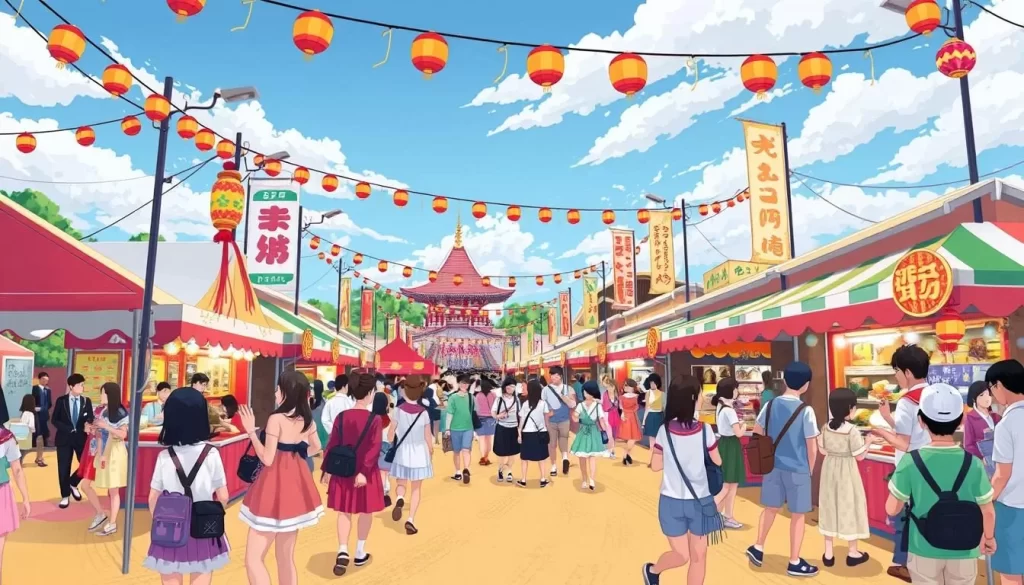
August: Peak Heat and Typhoon Awareness
August is typically the hottest month in Okayama, with high temperatures and humidity making it feel even more sweltering. It’s also a time when typhoons can affect the region, potentially impacting travel plans. However, August is also a month filled with exciting events, including the Obon festival in mid-August, which honors the spirits of ancestors.
To beat the heat, consider visiting Okayama’s many water-based attractions, such as its beaches and cooling spots. The evenings are also a great time to enjoy outdoor events and festivals, which are less affected by the daytime heat.
As you plan your trip, stay informed about weather forecasts to be prepared for any potential typhoons. August is also a peak time for domestic travel during the Obon holidays, so expect larger crowds at popular destinations.
Autumn in Okayama: September to November
From the lingering warmth of September to the crisp air of November, autumn in Okayama offers a diverse range of experiences for travelers. As the seasons change, the prefecture transforms into a kaleidoscope of colors, with comfortable temperatures making it an ideal time to explore.
September: Transitioning from Summer Heat
In September, Okayama begins its transition from the sweltering summer heat to the milder temperatures of autumn. While the weather can still be quite warm, the crowds start to dissipate, making it a good time to visit popular spots before the peak autumn season. The average high temperature is around 28°C (82°F), gradually decreasing as the month progresses.
October: Prime Time for Fall Foliage
October is a prime time to experience Okayama’s stunning autumn foliage. The Korakuen Garden and other parks and temples become vibrant with color as the leaves change, creating breathtaking landscapes. It’s an ideal month for hiking and exploring the outdoors, with comfortable temperatures ranging from 10°C to 20°C (50°F to 68°F).
The best autumn foliage spots in Okayama include:
- Korakuen Garden: A historic garden renowned for its beautiful autumn colors.
- Okayama Castle: The castle grounds are particularly picturesque during autumn.
- Makibi Park: Offers scenic hiking trails with stunning views of the autumn foliage.
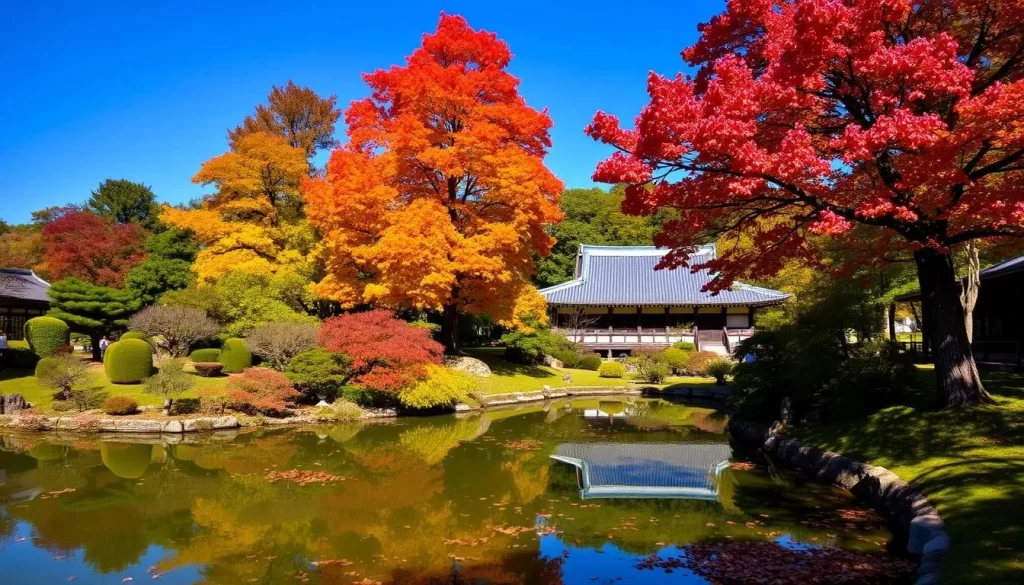
November: Crisp Weather and Fewer Crowds
November brings crisp, clear weather to Okayama, with average highs around 17°C (63°F), making it one of the most pleasant months to visit. While popular autumn leaf viewing spots can still attract crowds, the overall number of tourists is significantly lower than during the peak summer months or cherry blossom season. This makes it an excellent time for a more relaxed travel experience, enjoying hiking trails, cultural events, and the prefecture’s natural beauty without the hustle and bustle.
Winter in Okayama: December to February
The winter months in Okayama Prefecture are a time for celebration, clear skies, and the early signs of spring. As you visit during this period, you’ll experience the unique charm of Okayama’s winter landscape.
December: Winter Festivities and Year-End Celebrations
December marks the beginning of winter in Okayama, with average temperatures ranging from 2°C to 10°C (36°F to 50°F). The month is filled with festive atmosphere, including winter illuminations and year-end celebrations. You can enjoy the beautiful light displays at popular spots like Korakuen Garden and Okayama Castle. December is also a great time to try local winter delicacies, such as hot pot dishes and seasonal fruits.
Some of the key events in December include the Okayama Christmas Market and the New Year (Oshogatsu) preparations. You can experience the local culture by visiting shrines and temples, which are beautifully decorated during this time.
January: Coldest Month with Clear Skies
January is the coldest month in Okayama, with temperatures sometimes dropping below freezing. However, the clear skies make it an ideal time for sightseeing. You can enjoy winter sports like skiing at resorts such as the Okayama International Circuit or simply take in the crisp air while exploring the city’s historical sites.
January is also a time for New Year festivities, known as “Oshogatsu,” where you can visit local shrines and temples to experience traditional Japanese culture. Some popular spots include Kibitsu Shrine and Okayama Shrine.
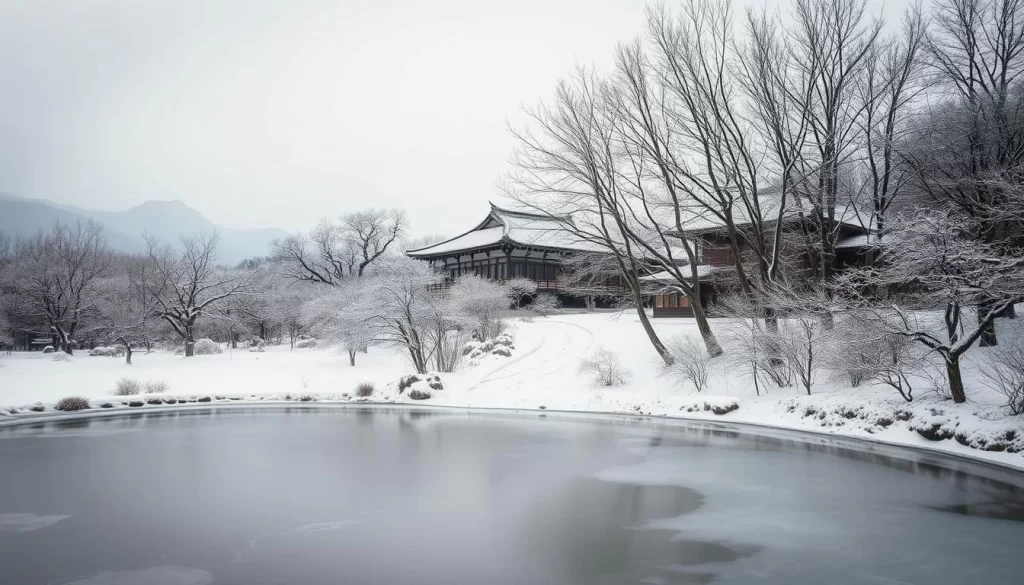
February: Winter’s End and Early Plum Blossoms
February remains chilly, but the days are gradually getting longer, signaling the approaching end of winter. One of the highlights of February is the plum blossom (ume) viewing, which typically starts in late February. You can visit spots like the Okayama Plum Blossom Festival to enjoy these beautiful flowers.
February is also a great time to experience Setsubun celebrations, marking the beginning of spring according to the lunar calendar. You can participate in traditional events and enjoy local foods associated with this celebration.
| Month | Average Temperature | Key Events |
|---|---|---|
| December | 2°C to 10°C (36°F to 50°F) | Winter illuminations, Christmas Market |
| January | Below freezing to 5°C (23°F to 41°F) | Oshogatsu (New Year festivities) |
| February | 2°C to 10°C (36°F to 50°F) | Plum blossom viewing, Setsubun celebrations |
Okayama Prefecture, Japan: Best Months for a Weather-Savvy Trip
Planning a trip to Okayama Prefecture requires more than just picking a destination; it demands timing your visit perfectly. The prefecture’s diverse climate and seasonal attractions mean that the right time to visit can significantly enhance your travel experience.
Optimal Months for Comfortable Weather
The months of April, May, October, and November are considered optimal for comfortable weather in Okayama. During April and May, the spring weather is mild and pleasant, with temperatures ranging from 15°C to 25°C (59°F to 77°F), making it ideal for outdoor activities like cherry blossom viewing and hiking. Similarly, October and November offer comfortable autumn weather, with temperatures between 10°C to 20°C (50°F to 68°F), perfect for enjoying the fall foliage.
Best Times to Avoid Crowds
If you’re looking to avoid the crowds, consider visiting Okayama during the shoulder season. The periods just before and after the peak tourist seasons, typically late March to early April and mid-October to early November, offer a more relaxed atmosphere. Avoiding Japanese national holidays and school vacation periods can also significantly reduce your encounter with crowds.
Budget-Friendly Travel Periods
For travelers on a budget, Okayama offers several affordable periods. Hotel and flight prices tend to be lower during the rainy season in June and winter months (December to February), except at ski resorts. These periods can provide significant savings on accommodations and travel costs. Here’s a comparison of average costs during different seasons:
| Season | Average Hotel Price | Average Flight Price |
|---|---|---|
| Peak Season (Cherry Blossom) | $150/night | $800/round trip |
| Rainy Season (June) | $80/night | $500/round trip |
| Winter (December to February) | $60/night | $400/round trip |
By choosing to visit during these budget-friendly periods, you can enjoy Okayama’s attractions without breaking the bank. Additionally, considering budget-friendly activities and experiences available year-round can further enhance your trip’s value.
Top Seasonal Attractions in Okayama
From historic gardens to majestic castles, Okayama’s seasonal attractions are a treat to explore. The prefecture is rich in cultural heritage and natural beauty, making it an ideal destination for travelers seeking unique experiences throughout the year.
Korakuen Garden Through the Seasons
Korakuen Garden, one of Japan’s Three Great Gardens, is a must-visit attraction in Okayama. Its beauty evolves with the seasons, offering a different experience with each visit.
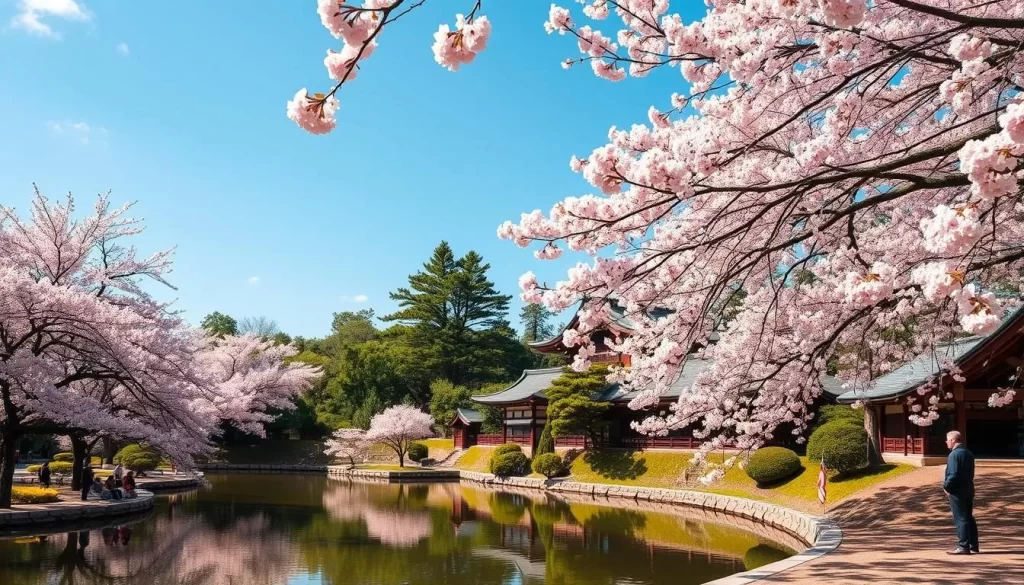
In spring, the garden is adorned with vibrant cherry blossoms. Summer brings lush greenery and tranquil water features. Autumn foliage is a highlight, with maple trees turning brilliant shades of orange and red. Even in winter, the garden’s serene landscape, often covered in a light dusting of snow, is a peaceful retreat.
Okayama Castle’s Seasonal Beauty
Okayama Castle, also known as the “Crow Castle” due to its black exterior, is another iconic attraction. Its seasonal beauty is captivating, with each season offering a unique perspective on this historic site.
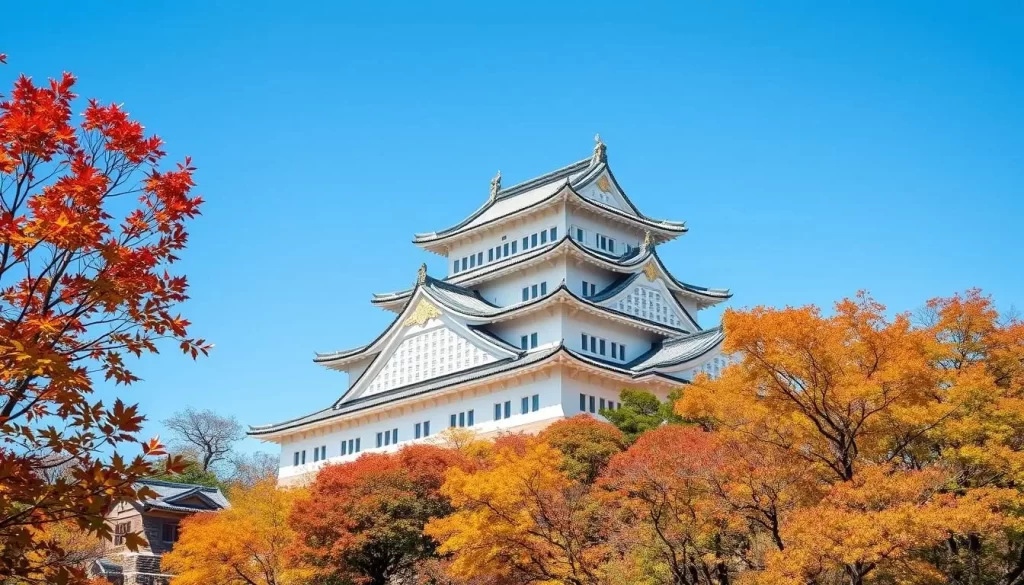
The castle’s gardens change with the seasons, much like Korakuen Garden. Visitors can enjoy the castle’s museum and learn about its history while taking in the surrounding seasonal landscapes.
Kibitsu Shrine and Seasonal Festivals
Kibitsu Shrine, a significant cultural and historical site, hosts various seasonal festivals throughout the year. These events are an integral part of Japanese cultural life, offering insights into traditional practices and community spirit.
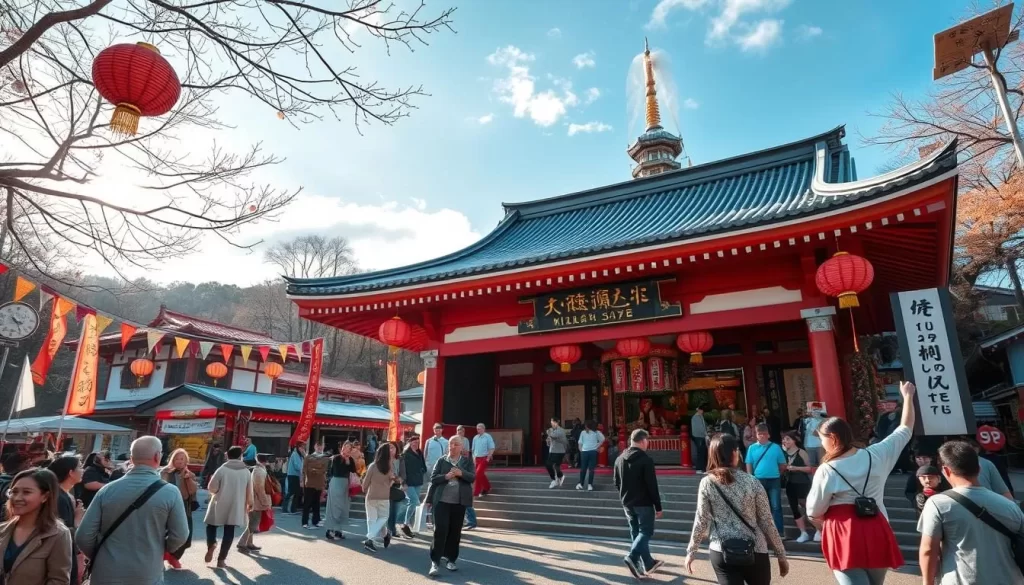
The shrine’s atmosphere and activities change with the seasons, from New Year (Oshogatsu) celebrations to autumn festivals. Visitors can experience traditional ceremonies, enjoy local food, and participate in cultural events, making Kibitsu Shrine a compelling destination for those interested in Japanese culture and seasonal attractions.
Okayama’s top seasonal attractions offer a blend of natural beauty, cultural heritage, and community spirit, making it a fascinating place to visit at any time of the year. Whether you’re interested in historic sites, cultural events, or simply enjoying the changing seasons, Okayama has something to offer.
Seasonal Outdoor Activities in Okayama
From hiking and water activities to cycling and mountain exploration, Okayama’s varied landscapes provide the perfect backdrop for outdoor enthusiasts. As you plan your trip, consider the unique experiences each season has to offer.
Spring Hiking Routes and Nature Walks
Spring is a wonderful time to explore Okayama’s great outdoors, with mild temperatures and blooming flora making it ideal for hiking and nature walks. You can discover scenic trails that wind through blooming cherry blossoms and vibrant spring foliage.
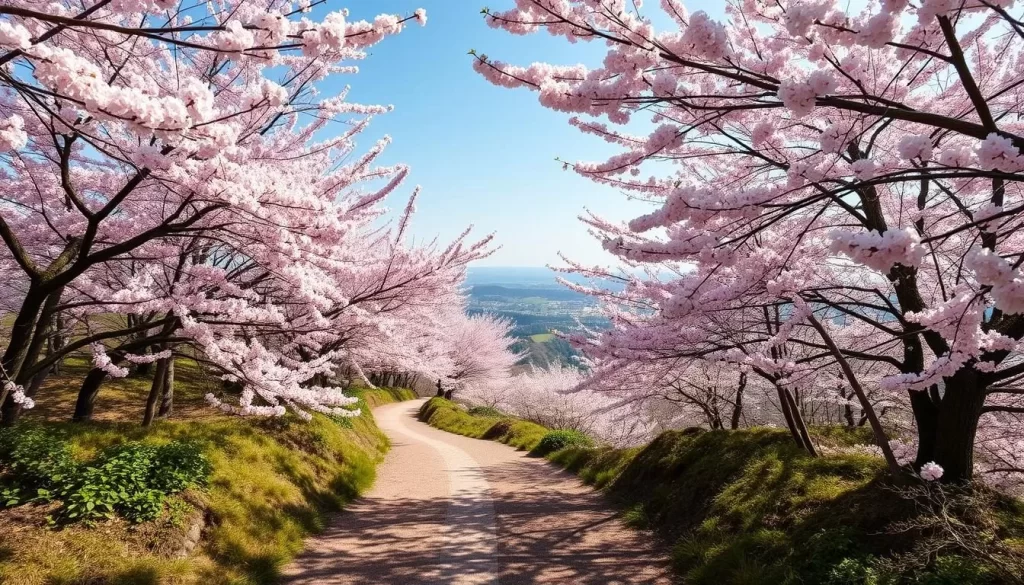
Some popular hiking spots include the trails around Mount Washu and the Kibi Plain, offering a mix of historical sites and natural beauty. Whether you’re a seasoned hiker or just looking for a leisurely stroll, Okayama has something for everyone.
Summer Water Activities and Beach Destinations
Summer in Okayama brings warm weather and a range of water activities, making it the perfect time to enjoy the prefecture’s beaches and coastal areas. You can relax on the sandy shores of Kojima Bay or engage in water sports like surfing and paddleboarding.

The Seto Inland Sea offers a serene backdrop for a day out on the water, with numerous beaches and islands to explore. Whether you’re looking to relax or be active, Okayama’s summer water activities have something for everyone.
Autumn Cycling and Mountain Exploration
Autumn is considered one of the best seasons for outdoor activities in Japan, with comfortable temperatures and beautiful foliage making it ideal for cycling and mountain exploration. You’ll discover Okayama’s most scenic autumn cycling routes that showcase the prefecture’s colorful fall foliage and rural landscapes.
Mountain exploration opportunities abound during autumn, with comfortable temperatures and clear visibility making it perfect for hiking and taking in the breathtaking views from mountain viewpoints. You can also combine your cycling or mountain exploration with visits to autumn festivals, hot springs, or harvest activities for a comprehensive fall experience.
Cultural Experiences by Season
Immerse yourself in Okayama’s cultural richness, where every season brings new festivals, traditions, and experiences to enjoy. The prefecture’s cultural calendar is filled with events that reflect its history, agricultural heritage, and the changing seasons.
Traditional Spring Celebrations
Spring in Okayama is a time of renewal and celebration. The cherry blossom viewing (hanami) is a major event, with many parks and gardens hosting festivities. You can also experience traditional spring rituals at shrines and temples, such as the Setsubun festival, which marks the beginning of spring.
Summer Matsuri and Fireworks
Summer in Okayama is vibrant, with numerous matsuri (festivals) and fireworks displays. One of the highlights is the Okayama Summer Festival, which features traditional dances, food stalls, and a spectacular fireworks show over the Asahi River. These events showcase the community’s spirit and offer a unique cultural experience.
Autumn Harvest Festivals
Autumn is a season of gratitude in Okayama, with harvest festivals celebrating the region’s agricultural bounty. You can participate in traditional thanksgiving ceremonies at shrines and temples, such as the Kibitsu Shrine, which hosts a harvest festival with traditional dances and food offerings. The season is also ideal for experiencing moon-viewing (tsukimi) traditions, a poetic Japanese custom where you can appreciate the full moon’s beauty.
| Season | Cultural Experience | Location |
|---|---|---|
| Spring | Cherry Blossom Viewing | Korakuen Garden |
| Summer | Matsuri and Fireworks | Asahi River |
| Autumn | Harvest Festivals | Kibitsu Shrine |
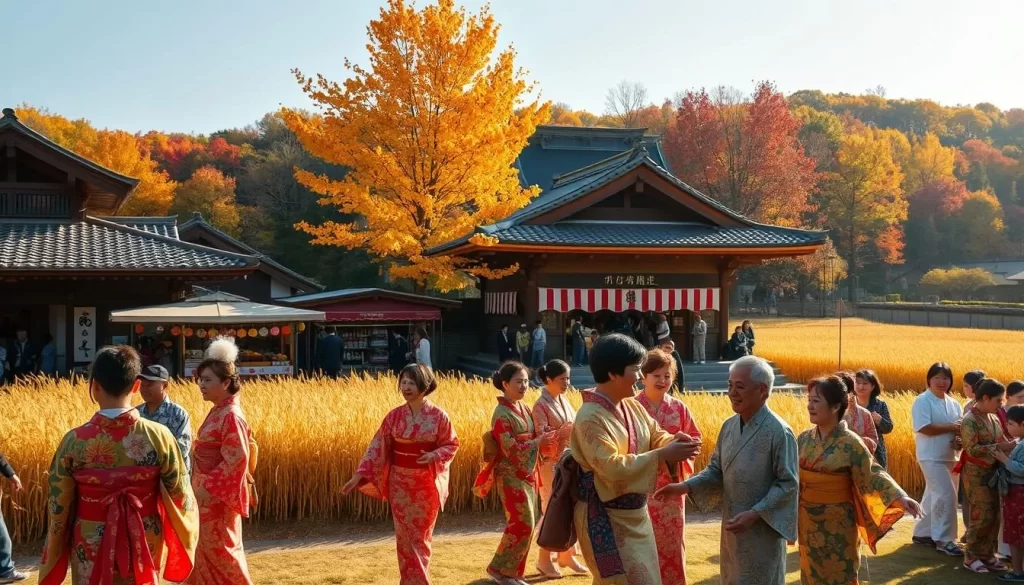
Okayama’s cultural experiences are deeply intertwined with its natural beauty and the changing seasons. By participating in these events, you’ll gain a deeper understanding of the local culture and traditions, making your visit even more memorable.
Seasonal Cuisine of Okayama
In Okayama, the changing seasons are not just a backdrop for the local cuisine but a defining characteristic of it. As you explore the region, you’ll find that the culinary landscape transforms with the seasons, offering a diverse array of flavors and dishes to enjoy.
Spring Delicacies and Fresh Produce
Spring in Okayama brings an explosion of fresh produce, with ingredients like bamboo shoots and young vegetables making their way into local dishes. You can savor the taste of spring with Okayama’s famous peach dishes, enjoyed during the peach blossom season. The region is also known for its Sanshu persimmons, which are often dried or made into sweets.
As the season progresses, the variety of produce expands, including fragrant herbs and edible flowers that add unique flavors to traditional Okayama recipes.
Summer Specialties and Refreshing Dishes
Summer in Okayama is characterized by hot and humid weather, making refreshing dishes a staple of the season. You can enjoy cooling somen noodles, a popular summer treat, or savor the region’s famous peaches and melons. The warmer months also see a variety of summer festivals, where local street food plays a significant role in the celebrations.
For a truly immersive culinary experience, consider visiting local markets or trying your hand at preparing traditional summer dishes with fresh, seasonal ingredients.
Autumn and Winter Comfort Foods
As autumn transitions into winter, Okayama’s cuisine shifts towards hearty, warming dishes designed to provide comfort during the colder months. You can indulge in hot pot dishes made with seasonal ingredients like mushrooms, chestnuts, and root vegetables, all of which are locally sourced.
| Season | Key Ingredients | Popular Dishes |
|---|---|---|
| Autumn | Mushrooms, Chestnuts, Persimmons | Hot Pot, Grilled Chestnuts |
| Winter | Root Vegetables, Seafood | Nabe (Hot Pot), Oden |
Winter is also considered prime time for enjoying seasonal sake, produced using traditional methods and locally sourced rice. For a unique culinary experience, visit one of Okayama’s local breweries or try a traditional Japanese meal paired with a glass of sake.
Day Trips from Okayama by Season
The changing seasons bring new experiences to Okayama’s neighboring areas, making for memorable day trips. Whether you’re looking for cultural exploration, natural beauty, or relaxation, the region around Okayama offers a diverse range of destinations that cater to various interests throughout the year.
Spring: Kurashiki and Washuzan
In the spring, Kurashiki is a must-visit destination, with its historic canal area and beautiful cherry blossoms. You can stroll along the canal, visit the Kurashiki Bikan Historical Quarter, and enjoy traditional Japanese architecture. Washuzan, on the other hand, offers breathtaking views of the Seto Inland Sea and is particularly lovely during the spring when the cherry blossoms are in bloom.
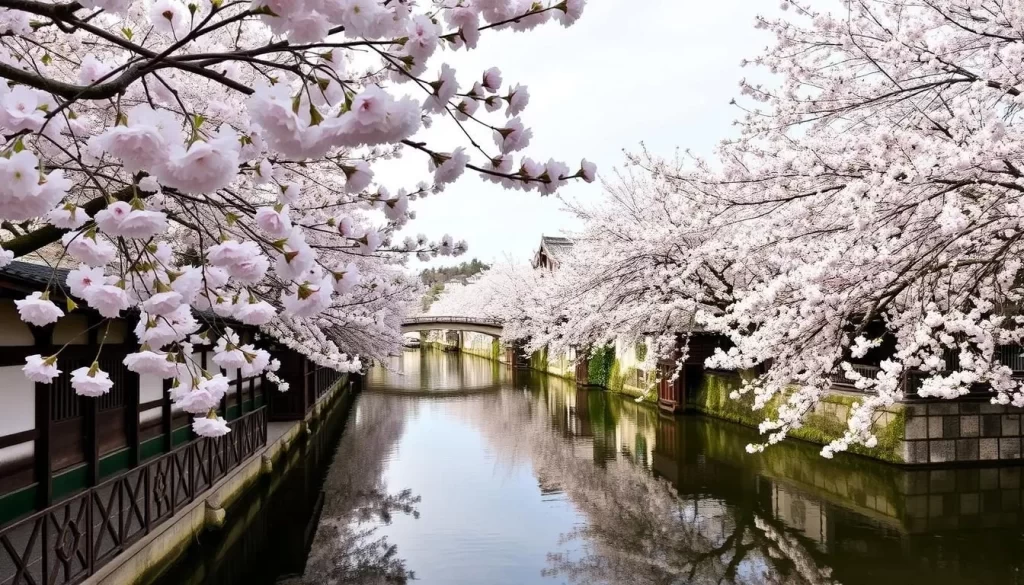
Summer: Kojima and Seto Inland Sea
Summer is the perfect time to enjoy the beaches and water activities around Kojima and the Seto Inland Sea. You can relax on the beach, go swimming, or try your hand at water sports like kayaking or paddleboarding. The scenic views of the islands and the sea are especially stunning during this time of year.
Autumn and Winter: Yunogo Onsen and Tsuyama
As autumn arrives, Yunogo Onsen becomes a serene retreat, offering hot spring bathing amidst the beautiful fall foliage. In the winter, the hot springs are especially inviting, providing a warm respite from the cold. Tsuyama, known for its historic castle and gardens, is another great destination during autumn, with its vibrant fall colors, and in winter, it occasionally experiences a gentle dusting of snow, creating a picturesque landscape.
When visiting these destinations during the colder months, be sure to check transportation schedules and weather advisories. Enjoy warming local foods and drinks, such as hot sake or regional specialties, to enhance your day trip experience.
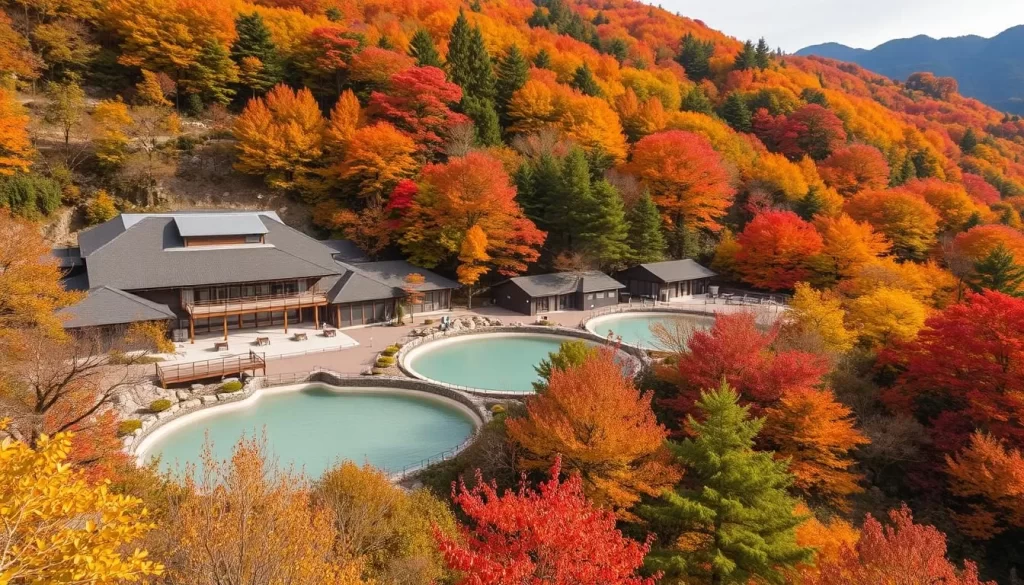
Packing Tips for Each Season in Okayama
To make the most of your trip to Okayama Prefecture, it’s essential to pack wisely according to the season. Okayama’s climate varies significantly throughout the year, making it crucial to prepare your luggage with the right items for the time of your visit.
Spring and Autumn Essentials
During spring and autumn, Okayama experiences mild temperatures, making these seasons ideal for outdoor activities. For these periods, pack layers, including lightweight jackets and comfortable walking shoes. You’ll also want to include an umbrella, as spring showers are not uncommon, and autumn can occasionally see rain. Comfortable clothing for layering is key, as the temperature can fluctuate significantly between morning and afternoon.

Summer Heat Survival Kit
Summer in Okayama can be quite hot and humid. To survive the heat, pack lightweight, breathable clothing, sunscreen with a high SPF, a hat, and sunglasses. Don’t forget to include insect repellent, as mosquitoes can be prevalent during this season. Staying hydrated is crucial, so consider packing a refillable water bottle.
Winter Comfort Items
Winter in Okayama requires warm clothing, although it may not be as cold as in some other parts of Japan. Pack warm layers, including a good coat, gloves, and a hat. Thermal underwear can be beneficial for colder days. If you plan on enjoying snow activities or visiting areas that may experience snow, waterproof boots are a good idea. Indoor heating practices in Japan might differ from what you’re used to, so dressing in layers will help you adjust to varying indoor temperatures.
By packing appropriately for the season, you’ll be able to enjoy Okayama’s attractions in comfort, whether you’re exploring the historic sites on foot or enjoying the natural beauty of the area. The weather in Okayama can be quite changeable, so being prepared is the best way to ensure a pleasant trip.
Accommodation Recommendations by Season
Okayama’s accommodation scene is as dynamic as its climate, offering seasonal stays that enhance your travel experience. Whether you’re looking for a place to stay during the cherry blossom season, a cool retreat in the summer, or a cozy winter getaway, Okayama has a wide range of options to suit your needs.
Where to Stay During Cherry Blossom Season
During the cherry blossom season, it’s advisable to book hotels near popular spots like Korakuen Garden or Okayama Castle to make the most of the beautiful blooms. Hotels with a view of the castle or garden can offer a truly unforgettable experience.
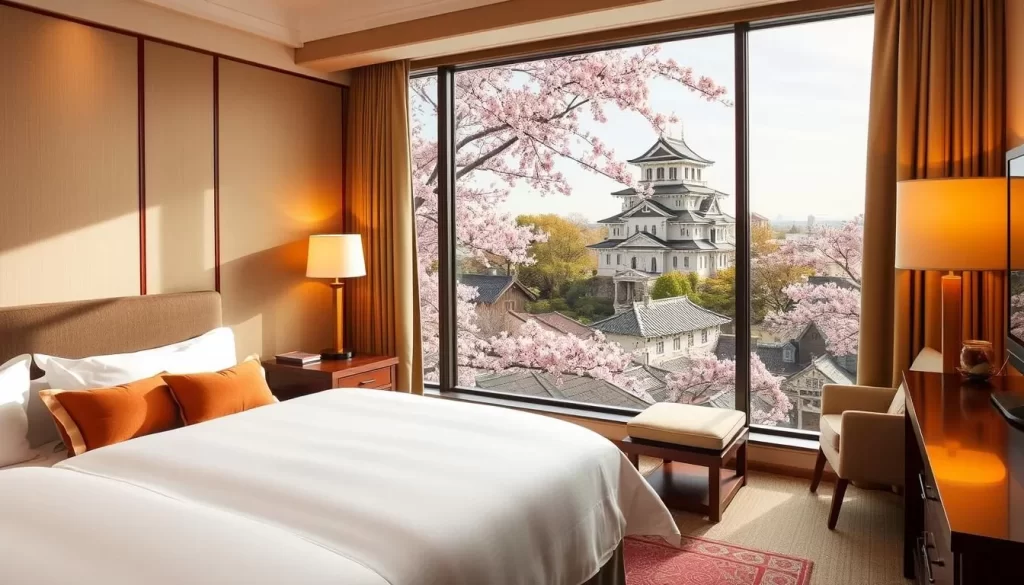
Summer Accommodations with Cooling Features
In the summer, look for accommodations with cooling features such as pools, air conditioning, or even traditional Japanese cooling methods like yukimi-ro (snow-viewing rooms), although the latter is more of a winter feature, some ryokans offer unique cooling spaces.
Some hotels and ryokans offer special summer packages that include access to cooling facilities or relaxing areas to help you beat the heat.
Cozy Winter Retreats and Ryokans
Winter is a great time to experience traditional Japanese hospitality at a ryokan. Look for places that offer heated tables (kotatsu), hot spring baths, and cozy futon arrangements to keep you warm and comfortable.
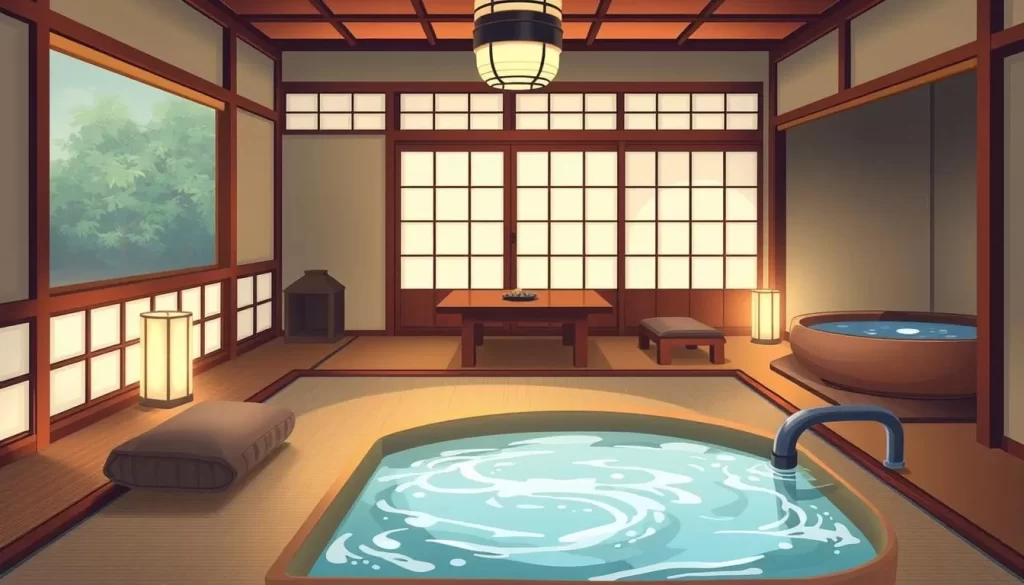
Traditional Japanese ryokans often provide especially cozy winter experiences. You’ll enjoy warm baths, seasonal cuisine, and unique winter comfort features that make your stay truly special.
Transportation Considerations Throughout the Year
Navigating Okayama efficiently requires an understanding of how transportation options evolve with the seasons. The city’s infrastructure is designed to accommodate visitors year-round, but the best way to explore can vary significantly depending on the time of year you visit.
Navigating Okayama During Peak Tourist Seasons
During peak tourist seasons, such as cherry blossom season in spring and autumn foliage, Okayama’s transportation systems can get crowded. It’s advisable to plan your trip in advance, considering the use of seasonal transportation passes or discounts that can make your travel more convenient and cost-effective. For instance, the Okayama City Tourist Pass offers unlimited travel on city buses and trams, making it easier to explore popular areas without the hassle of driving.
- Use public transportation like buses and trams for an efficient way to get around.
- Consider purchasing a prepaid IC card for easy travel.
- Be prepared for crowds at major stations and tourist hotspots.
Weather-Related Transportation Challenges
Okayama experiences a range of weather conditions throughout the year, from the rainy season in June to potential typhoons in late summer. Understanding these weather-related challenges can help you plan your transportation. For example, during the rainy season, covered shopping arcades become a convenient way to navigate the city without getting wet. In contrast, the mild weather of spring and autumn makes bicycle rentals a popular and enjoyable way to explore Okayama.
Best Transportation Options by Season
The best transportation options in Okayama vary by season. In spring, enjoy the scenic views on train lines that pass through cherry blossom trees. Summer might be the perfect time for a boat cruise on the Asahi River. Autumn offers a picturesque backdrop for cycling or taking a leisurely walk. In winter, the city’s covered walkways can be a comfortable way to explore while staying warm.
- Spring: Train rides with cherry blossom views, bicycle rentals.
- Summer: Boat cruises, covered shopping arcades during rainy days.
- Autumn: Cycling, walking tours.
- Winter: Covered walkways, efficient public transportation.
By understanding the transportation options available during different seasons, you can plan your trip to Okayama more effectively, ensuring a smooth and enjoyable journey through this beautiful Japanese city.
Planning Around Japanese Holidays and Peak Seasons
When visiting Okayama Prefecture, Japan, it’s essential to be aware of the major Japanese holidays that can impact your travel plans. Japan’s unique culture and traditions are deeply rooted in its holidays, which can be both a fascinating experience and a challenge for travelers.
Golden Week Impact on Okayama Tourism
Golden Week is a week-long holiday period in Japan that usually takes place from April 29 to May 5. During this time, many Japanese people take time off work, leading to a significant influx of domestic tourists. Okayama Prefecture is no exception, with popular destinations becoming crowded. You can expect larger crowds at famous spots like Korakuen Garden and Okayama Castle. While this can be a lively and festive time to visit, it’s also a good idea to plan ahead and book accommodations and popular attractions in advance to avoid any inconvenience.
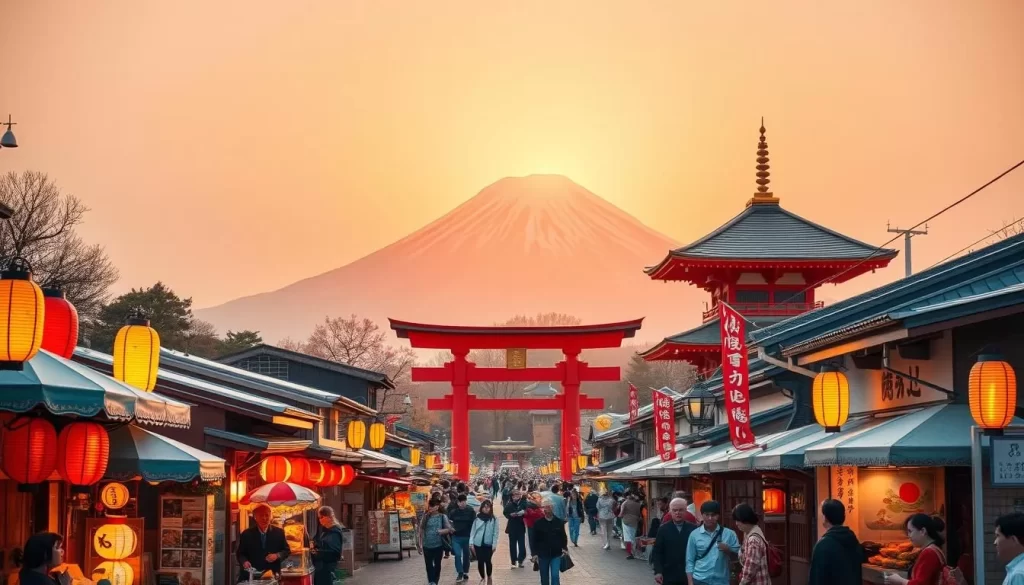
Obon Festival Period
The Obon Festival, typically occurring in mid-August, is another significant holiday period in Japan. It’s a time when families honor their ancestors, and many people return to their hometowns. While Obon can be a fascinating cultural experience, with many temples and shrines hosting events, it also means that popular tourist spots may be crowded. You might also notice that some businesses close temporarily as owners return to their hometowns. Planning your itinerary around Obon can help you make the most of your visit to Okayama.
| Holiday | Date | Impact on Tourism |
|---|---|---|
| Golden Week | April 29 – May 5 | Crowded popular destinations |
| Obon Festival | Mid-August | Crowded temples and shrines, some businesses closed |
| New Year | December 29 – January 4 | Many businesses closed, increased domestic travel |
New Year and Other Major Holidays
The New Year (Shogatsu) is one of Japan’s most significant holiday periods, typically lasting from December 29 to January 4. Many businesses and attractions close during this time, although some temples and shrines remain open for hatsumode (first shrine visit of the year). You can experience traditional New Year activities and customs in Okayama, such as visiting local shrines and enjoying special New Year foods. Other major holidays like Seijin no Hi (Coming-of-Age Day) in January and Showa no Hi (Showa Day) in April can also affect travel plans.
By understanding these major Japanese holidays and planning accordingly, you can have a more enjoyable and stress-free trip to Okayama Prefecture. Whether you’re interested in cultural experiences, traditional customs, or simply want to avoid the crowds, being aware of these holidays will help you make the most of your visit to this beautiful region.
Insider Tips for Weather-Savvy Travelers to Okayama
The weather in Okayama can be quite unpredictable, making it essential for travelers to be flexible and informed. As you prepare for your trip, understanding the local climate and being prepared for various conditions can significantly enhance your experience.
Lesser-Known Weather Patterns and Local Knowledge
Okayama’s weather is influenced by its geographic location, with the Seto Inland Sea having a moderating effect on its climate. However, there are some lesser-known weather patterns that can impact your visit. For instance, the tsuyu or rainy season in June can bring significant rainfall, while the summer months can be quite hot and humid.
Locals often prepare for these conditions by carrying umbrellas and raincoats during the rainy season and staying hydrated during the hot summer days. Understanding these patterns can help you pack accordingly and make the most of your time in Okayama.
| Season | Weather Pattern | Local Tips |
|---|---|---|
| Spring | Mild temperatures, occasional rain | Carry an umbrella, enjoy cherry blossoms |
| Summer | Hot and humid, occasional typhoons | Stay hydrated, be prepared for sudden rain |
| Autumn | Comfortable temperatures, foliage | Enjoy outdoor activities, visit during fall foliage |
| Winter | Cool to cold, occasional snowfall | Pack warm clothing, enjoy winter landscapes |
Emergency Preparedness for Seasonal Weather Events
While Okayama’s weather can be unpredictable, being prepared for seasonal weather events can minimize disruptions to your travel plans. For example, during the typhoon season in late summer, it’s essential to stay informed about weather forecasts and have a plan in place in case of an emergency.
Locals and travelers alike should be aware of the emergency procedures in place, such as evacuation routes and shelters. Additionally, having a flexible itinerary can help you adapt to any unexpected weather conditions.
Making the Most of Unexpected Weather Changes
Unexpected weather changes can sometimes lead to unique and memorable experiences. For instance, a sudden rain shower can bring out the beautiful greenery in Okayama’s gardens, or a misty morning can create a mystical atmosphere in the mountains.
By being open to these changes and having alternative plans in place, you can turn what might seem like a disappointment into a wonderful experience. Whether it’s visiting an indoor museum or enjoying a traditional tea ceremony, there are plenty of ways to make the most of your day in Okayama, regardless of the weather.
Conclusion
The diverse climate of Okayama Prefecture means that the ideal time to visit depends on your personal preferences and priorities. As you’ve explored throughout this article, each season offers unique experiences and attractions.
Whether you’re planning a trip during the vibrant cherry blossom season or the serene autumn foliage, Okayama has something to offer. By understanding the weather patterns and seasonal highlights, you can make the most of your visit to this beautiful region of Japan.
Okayama Prefecture is a worthwhile destination at any time of the year, with its rich cultural heritage, natural beauty, and welcoming atmosphere. As you prepare to visit Japan, consider what each season has to offer, and you’ll be sure to have a memorable experience.
Embracing the Japanese appreciation for seasonal change will enhance your travel experience, allowing you to find beauty in each of Okayama’s distinct seasons.
The above is subject to change.
Check back often to TRAVEL.COM for the latest travel tips and deals.






